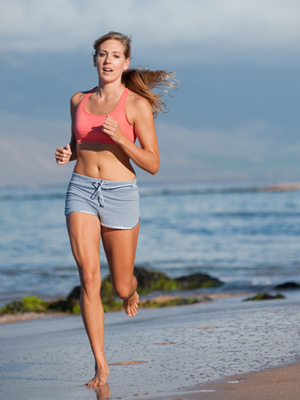Athlete’s Edge Series: Barefoot Running

Barefoot Running – Help or Hype?
Have you ever considered running barefoot? While that may seem a little out of the ordinary, runners all over the world are adopting this new style of running. Although the majority of runners still wear shoes, the debate rages on as to whether barefoot running is more natural and beneficial than wearing running shoes.
Is Barefoot Running Beneficial?
Barefoot running is more than a trend; it has become an athletic movement over the last few years. Proponents of barefoot running cite several benefits to the practice-specifically that it results in a more natural stride and reduces the risk of injury. Certain running shoes, they contend, create an abnormal running pattern and encourage runners to land on the heel of their foot, which leads to a heavier impact on the knees, legs, and feet. According to those in favor of this technique, running barefoot is the way that the body was naturally intended to run and is therefore better for the body.
The Case for Running Shoes
Wearing shoes is still common practice in the running community, and runners that are in favor of wearing shoes point to a number of advantages provided by the additional support and protection. One of the core benefits to wearing athletic shoes is that they protect the feet from debris or sharp objects on the street or track. Due to new developments and advancements in the design of athletic shoes, certain shoes are now designed to prevent running patterns that lead to injury. When transitioning to barefoot running from running with shoes, runners can also become prone to injury due to the difference in stride and impact.
The Impact of Barefoot Running on Performance
Recent research conducted by Dr. Hunter, a biomechanics researcher who works with elite athletes on the USA Track & Field team, indicates that there is no correlation between performance levels and barefoot running, as has been stated by those in favor of barefoot running. By studying how the runners’ feet hit the ground (whether on the mid-foot, forefoot, or heel), Dr. Hunter was able to determine that there is virtually no difference in running performance.
Barefoot Running Prevents “Heel-Striking” and Reduces Risk of Injury
Science has not produced a definitive stance on whether one style of running is more beneficial than the other, but there are some findings that give credence to the idea that barefoot running prevents “heel-striking.” Since people naturally land on the balls of the foot or the mid-foot when running barefoot, this can reduce athletes’ risk of injury and create a more natural stride.
How to Safely Transition to Barefoot Running
For runners that want to make the transition to barefoot running, experts agree that a full physical examination along with coaching from a professional running specialist or physical trainer can help condition the body to adjust to running barefoot. After the initial assessments, a gradual introduction to barefoot running will yield best results. Minimalist footwear can also help runners adjust to these changes.
